An article in the WESTON MERCURY AND SOMERSETSHIRE HERALD 30th Oct 1886 gives us an insight into the nature of charitable provision during Burnham’s early years:
It tells us that a public meeting under the auspices of the Charity Commission took place at the church vestry “for the purpose of enquiring into the foundation, endowments and objects of the several parish charities, their present circumstances and condition, and of ascertaining whether any and what improvements might be made in their management and application.”
A number of charitable bequests were reviewed:
The Rogers charity – founded by the will of Henry Rogers 1672 – rents on land to be distributed to 20 – 40 poor of Cannington, Porlock & Burnham. £32. 16s. 3d. had been received by Burnham the previous year and divided amongst 3 individuals.
The Harris, Card & Dean Charities. Nearly 150 years previously the Rev. Harris, vicar of Burnham, gave £10 to parish stock for the interest to be distributed in bread annually at the discretion of the ministers and churchwardens. In 1790 Mrs Card gave £10 similarly and in 1802 Jacob Dean gave £20. These charities had been lost sight of for probably 30 years. It was discovered that the combined amount of £40 had been inadvertently advanced to the Treasurer of the Union in 1841 and used for the building of dwellings for the poor. To rectify the situation these premises were sold and a claim for £40 from the proceeds was made but this also appeared to have been sidelined in some way. Further investigation was to be undertaken.
Golden’s Charity. In 1797 the Rev. John Golden, vicar of Burnham, bequeathed £100 of bank stock, half of the interest to be expended on religious books, to be distributed in Easter week, and half on bread to be distributed in Christmas week amongst the poorer residents of the parish.
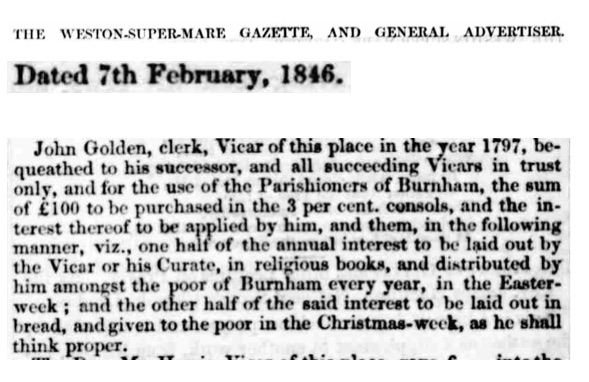
Later the National School had been one beneficiary of the books. Objections were raised to the system of bread distribution and it was thought advisable that new schemes for the administration of the charities should abandon this kind of relief.
Elizabeth Caroline Baldwin, spinster of Bath, bequeathed £100 in 1849 to produce annuities to be distributed to the sick and aged poor of Burnham.
Labourers’ Charity. The origin of this charity was unknown. 48/- distributed annually at Easter amongst the poor of the parish. Known as ‘day-labouring money’, it was paid from the rates. None of those present knew when it had last been administered!
Ellen’s Cottages: Land and cottages were conveyed by deed in 1863 to trustees, for occupation by 10 women of good character (not exclusively from Burnham) over 60 years of age. Appointments twere to be made by the vicar of the parish or other appropriate minister. Sums had been invested for provision of the services of a medical officer and a gardener, necessary repairs, a weekly allowance and Christmas bonus for the residents as well as for furnishings. It was noted that the houses were in good repair and the residents contented.
George Tucker bequeathed £130 for investment in 1859, half the interest to be applied to maintenance of the National School, the other half to be given to Huntspill for distribution.
Rev. David Davies of Burnham had bequeathed income from land of £2 annually to the vicar to apply to support of Sunday school.
————————————————————————————-
COAL CHARITY
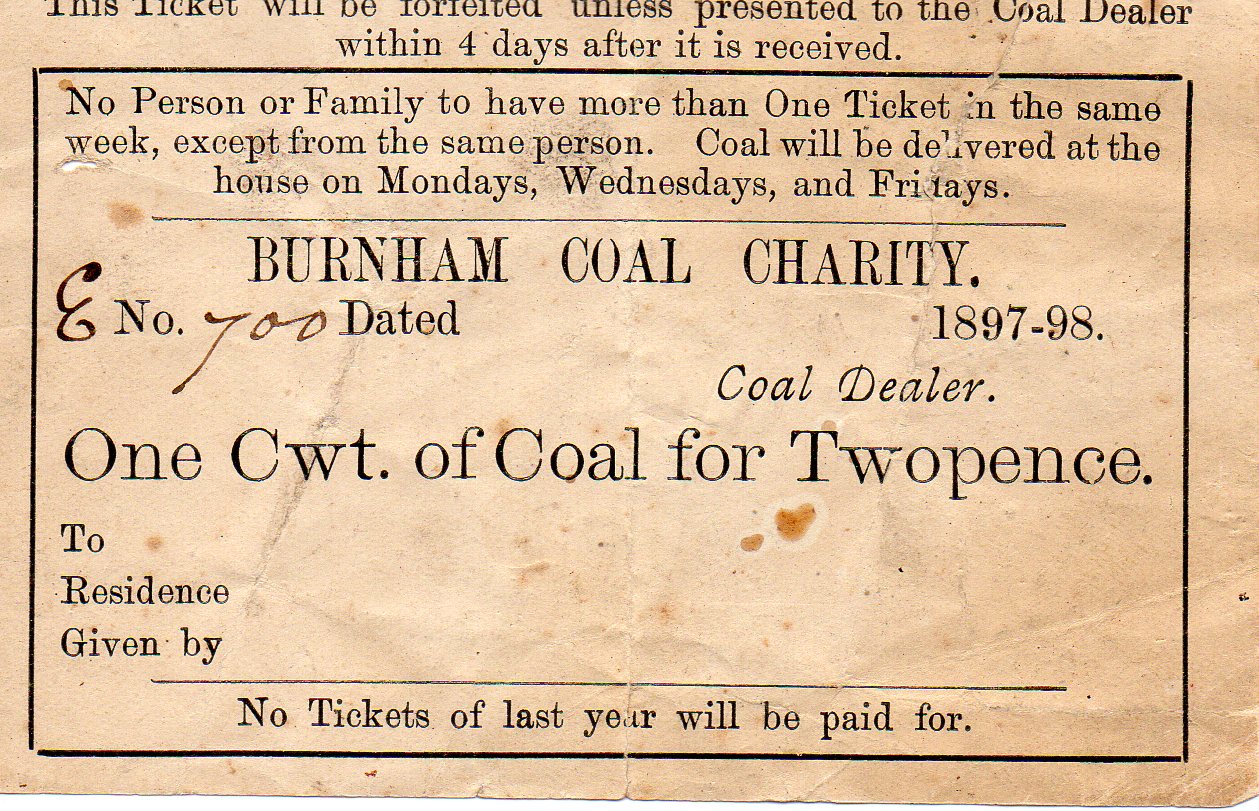
It is not clear whether the ‘Coal Club’ (below, 1902) was connected with this nor indeed whether it was a charitable venture or a co-operative, though the motto suggests it was a fund for the ‘deserving poor’.
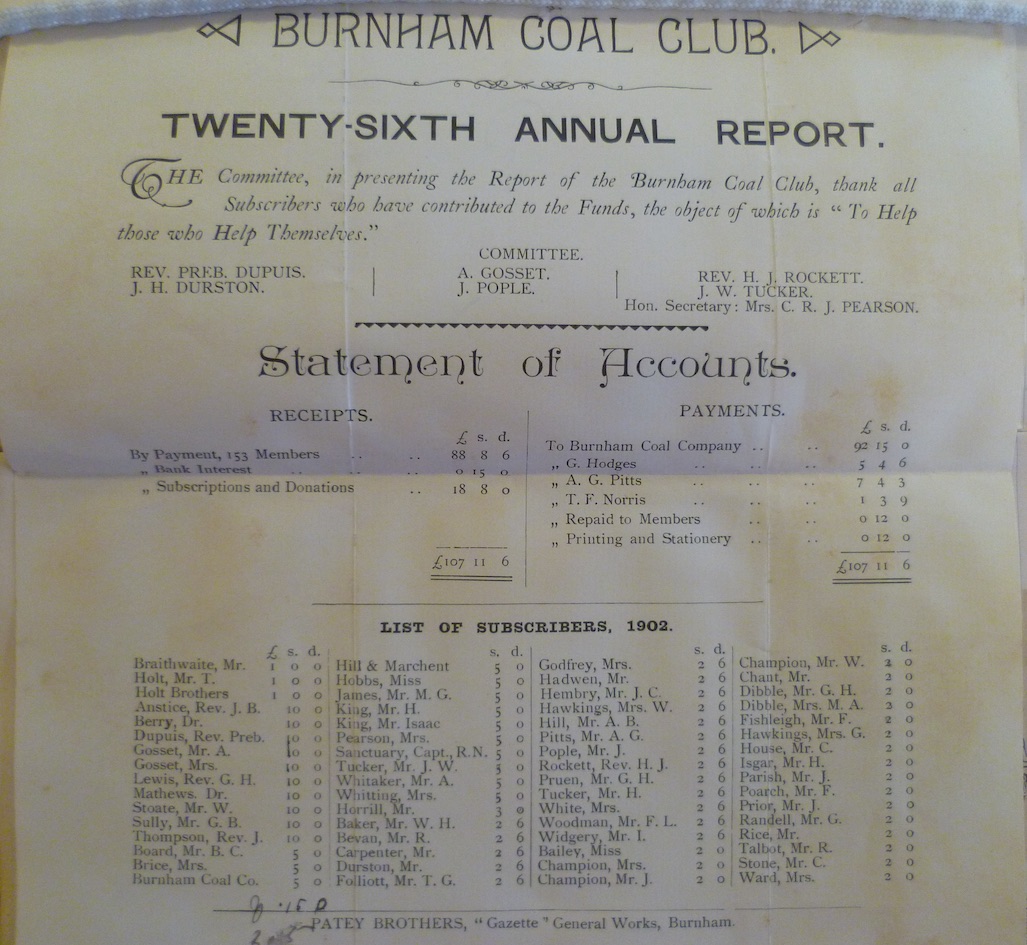
We know nothing more about these so any additional information would be welcome.
BURNHAM ROTARY CLUB
pages from a club bulletin, date unknown:
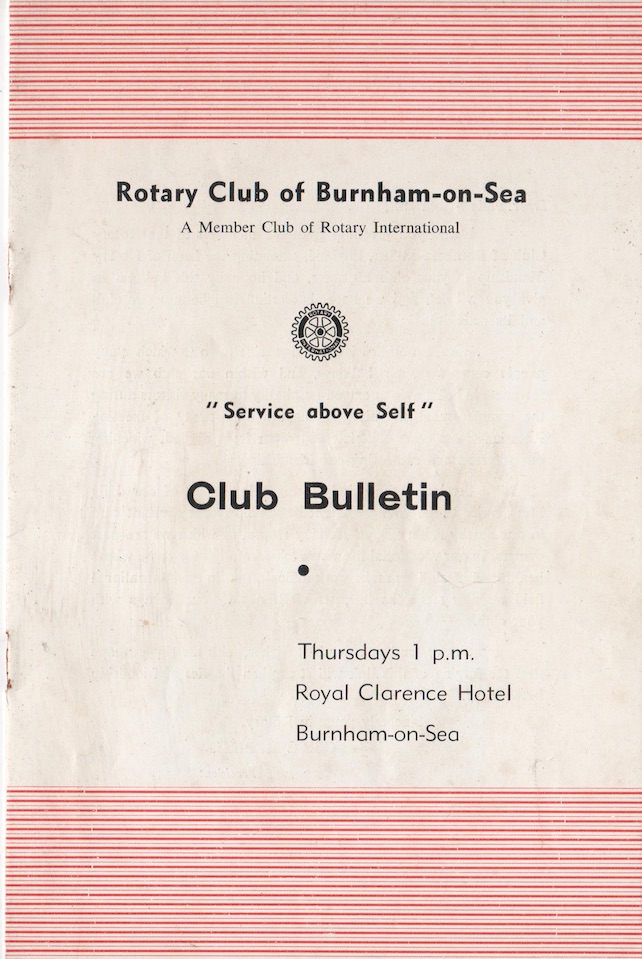
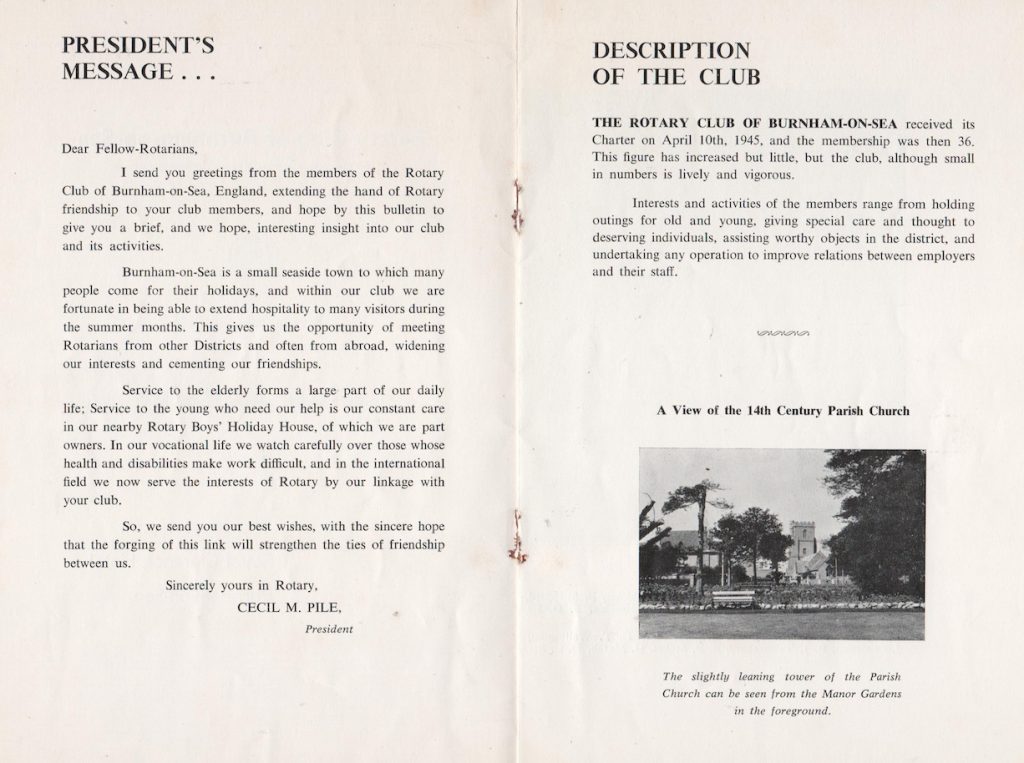
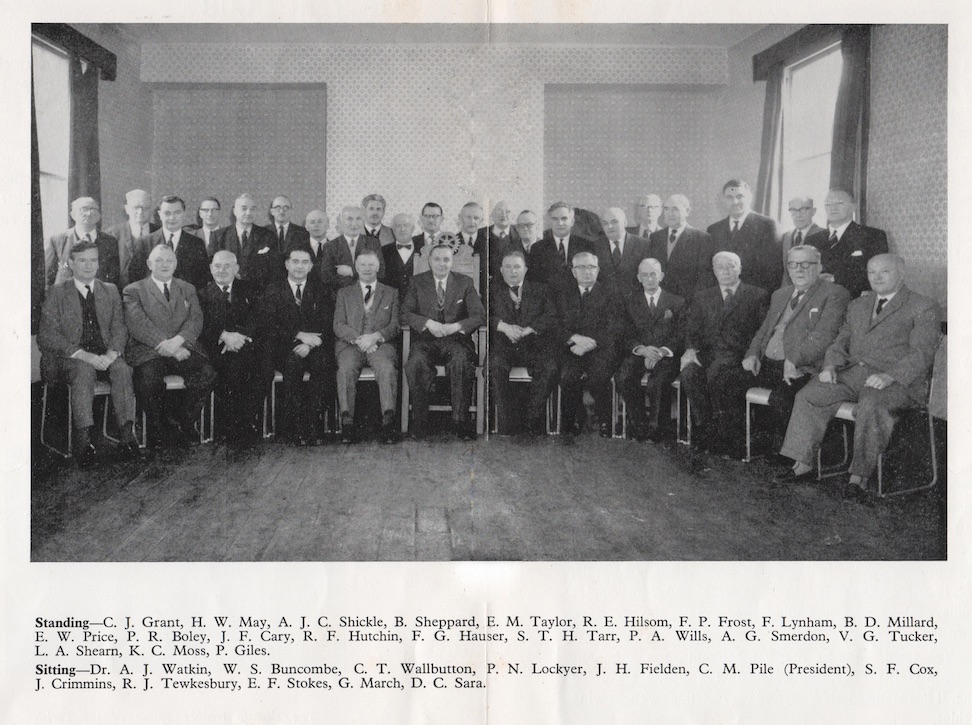
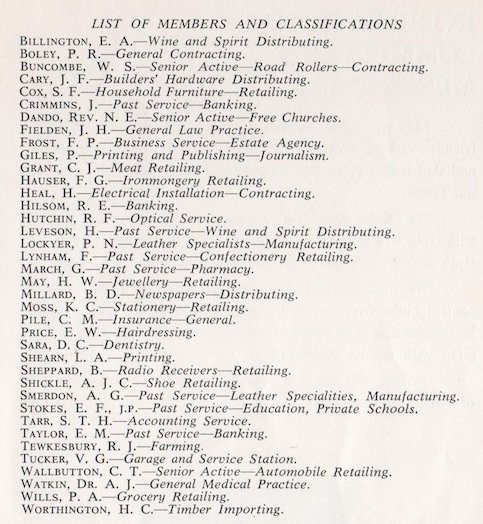
HOME AND FOREIGN MISSIONS
Western Daily Press 1939

Unfortunately the whereabouts of the 17th & 18th century documents referred to is presently unknown.
BURNHAM GIFT FUND
Photo from Glyn Luxon’s collection, 1940
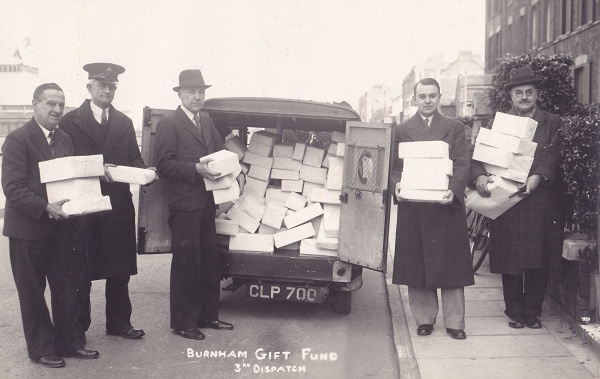
We have now discovered that this was a charitable drive during WWII to provide gifts for members of the armed forces (see Wartime page for further details).
THE JAN SMUTS’ HOME
Berrow Lodge, situated between the Berrow Rd and the sea just north of what is now Golf Links Rd, comprised part of what became the Warren Estate in 1907. A cottage had been built as a coach house to the Lodge in 1900. In 1943 the Estate was purchased by the South African Fund for Aid to Children. The money for this had been raised in South Africa. The Lodge became the Jan Smuts’ Home for children. The name, the choice of situation and the connection with South Africa are all probably accounted for by the fact that the Principal of the home was Petronella Clark, the married daughter of Jan Smuts and at the time a resident of Street.
Jan Smuts was then a very well known figure: a South African lawyer who had become a general in the Boer War (responsible for capture and interrogation of Winston Churchill); went on to become South Africa’s second prime minister and an architect of the ‘Union of South Africa’; and served as a British general and cabinet minister during WWI, becoming one of the signatories of the Treaty of Versailles at its conclusion. After the war Smuts had taken up an academic career and had been nominated for a Nobel Prize. In his writings he was possibly responsible for the introduction of the ‘holistic’ approach. During WWII Smuts became Churchill’s deputy in the war cabinet and was later a key founder of the Unite Nations. He subsequently continued as prime minister of the Union of South Africa, dying in 1950.
The remit of the Smuts home is not as yet clear to us, though it seems to have been involved in respite care of children. It was later gifted to the NHS which then sold it on in 1962 to Annie Kalra. She in turn sold the home in 1964 and its name was then changed to Burnham Lodge. In 1965 the cottage, nurses quarters and driveway were sold. The building continues in use today as the private Burnham Lodge Nursing Home for the elderly and the cottage is now a private residence.
THE SHIPWRECKED MARINERS’ SOCIETY
Taunton Courier 1866:


Hello Hugh,
You should now have a message concerning your comment. Please feel free to ask for details here.
Thanks for your comment,
John
I would like to contact you by email asap about the coal club ticket. Many thanks.